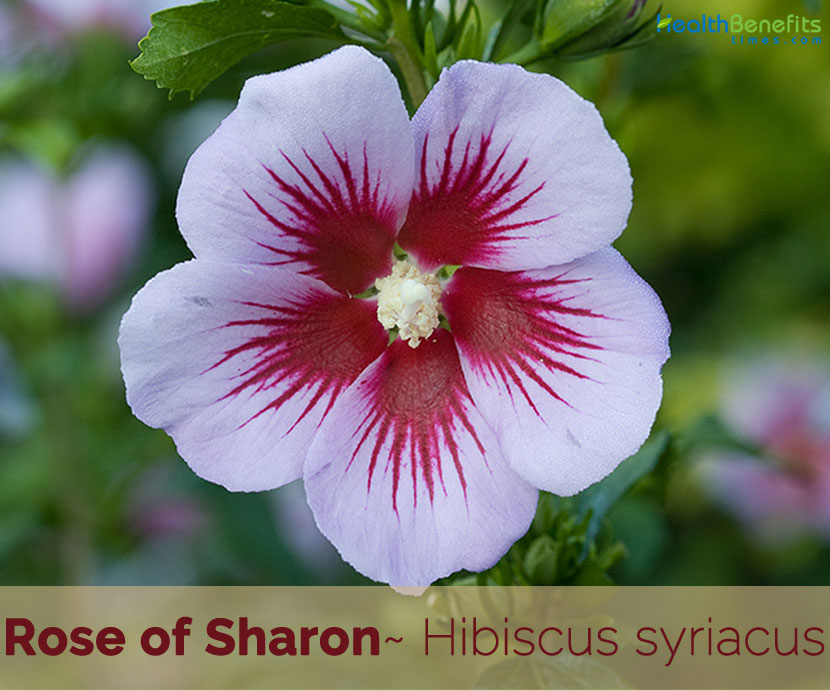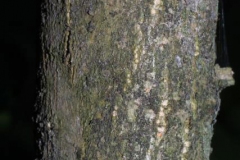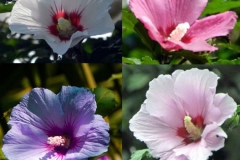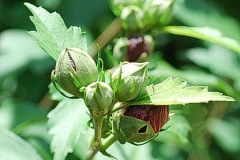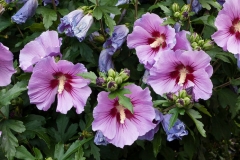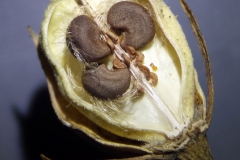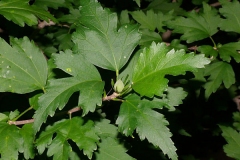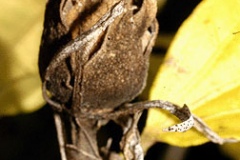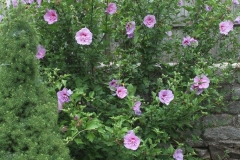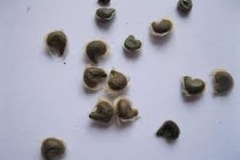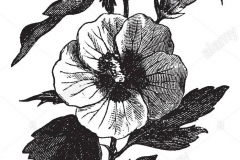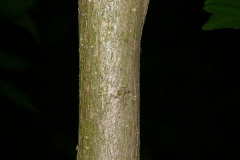| Rose of Sharon Quick Facts | |
|---|---|
| Name: | Rose of Sharon |
| Scientific Name: | Hibiscus syriacus |
| Origin | Asia including China, Northern India, Japan, Korea and also in Middle East, Europe and North America |
| Colors | Green or brown |
| Shapes | Capsule, globose-cylindrical, about 1.5-2.5 cm across, apex obtuse, abruptly beaked |
| Taste | Bitter, sweet |
| Health benefits | Beneficial for diarrhea, dysentery, abdominal pain, leucorrhoea, dysmenorrhea, dermaphytosis, skin diseases, dizziness and bloody stools |
| Name | Rose of Sharon |
|---|---|
| Scientific Name | Hibiscus syriacus |
| Native | Asia including China, Northern India, Japan, Korea and also in Middle East, Europe and North America where it was found before 1600 |
| Common Names | Rose mallow, Rose of Sharon, Shrub althaea, Shrubby althaea, Syrian hibiscus, Syrian rose, Syrian ketmia, Althea, Blue Hibiscus, Common Hibiscus, Hardy Hibiscus, Korean rose, St Joseph’s rod |
| Name in Other Languages | Albanian: Hibisk Arabic: Khatami suriun (خطمي سوري) Assamese: Swet-joba Armenian: Baghrjuk (Բաղրջուկ), siriakan vard (սիրիական վարդ), k’etmi (քետմի) Azerbaijani: Suriya hibiskusu Basque: Siriako arrosa Belarusian: Hibiskus siryjski (Гібіскус сірыйскі) Bulgarian: Dŭrvovidna ruzha (дървовидна ружа) Chinese: Mu jin (木槿) Croatian: Sirijski hibiscus, sirijska sljezolika Czech: Ibišek syrský Danish: Havehibiscus, Syrisk Rose Dutch: Althaeastruik, althaea boompje English: Rose mallow, Rose of Sharon, Shrub althaea, Shrubby althaea, Syrian hibiscus, Syrian rose, Syrian ketmia, Althea, Blue Hibiscus, Common Hibiscus, Hardy Hibiscus, Korean rose, St Joseph’s rod Finnish: Sinihibiskus French: Ketmie des jardins, Mauve de Syrie, Hibiscus, Ketmie, Hibiscus de Syrie, ketmie de Syrie, mauve en arbre German: Syrischer Rosen-Eibisch, Echter Roseneibisch, Straucheibisch, Eibisch, Rosen, Eibisch, Strauch, Eibisch, Syrischer, Roseneibisch, syrischer Eibisch Greek: Ivískos o Syriakós (ιβίσκος ο Συριακός) Hindi: Gurhul Hungarian: Kerti mályvacserje, törökrózsa Italian: Dialtea, Ibisco cinese, Rosa angelica, ibisco arborero, ketmia, ketmia syryjska, Japanese: Hachisu, Mokukinka, Mukuge (ムクゲ) Korean: Moo goong hwa, mugunghwa Maori (Cook Islands): Kaute vare‘au Netherland: Althaea boompje Persian: ختمی سوریهای درختی Polish: Ketmia syryjska Portuguese: Hibisco, Hibisco-da-síria, Altéia-arbustiva, Hibisco-colunar, Rosa-de-sharão, rosa-da-síria Romanian: Zămoșiță de Siria Russian: Gibiskus siriyskiy (Гибискус сирийский) Serbian: Oslez (ослез), šamlijan (шамлијан) Slovak: Ibištek sýrsky Spanish: Rosa de Siria Swedish: Frilandshibiskus, Thai: Chaba chin, Chba (ชบา) Turkish: Ağaçhatmi Uighur: پەرەڭگۈل Ukrainian: Hibiskus syriysʹkyy (Гібіскус сирійський) |
| Plant Growth Habit | Upright and vase-shaped, hardy deciduous shrub |
| Growing Climates | Sea cliffs, hillsides, along streams, roadsides, also extensively cultivated |
| Soil | Thrives on is a moist, but well-drained, mixture of sand, clay, chalk, and loam, maintaining an alkaline, neutral pH (5.5 – 7.0) level |
| Plant Size | About 8 to 15 feet tall and spreads 4 to 10 feet |
| Bark | Thin light gray bark |
| Branches | Thin and gray, white-lenticeled, with raised leaf scars and small buds |
| Stem | Woody, erect, branchlets densely pubescent with stellate hairs, becoming glabrous ultimately |
| Leaf | Simple, alternate, palmilobed or palmiparted, broadly ovate-deltoid to rhomboid-ovate, about 4-8 cm long and 2-5 cm across, base cuneate 3-5 veined |
| Flowering season | Early July to late October |
| Flower | Bisexual, pedicel slender, stellate pubescent, about 5-15 mm long, epicalyx 6-8, base connate, about 1-2 cm long, calyx 5 lobed, distinctly nerved, campanulate |
| Fruit Shape & Size | Capsule, globose-cylindrical, about 1.5-2.5 cm across, apex obtuse, abruptly beaked, dehiscing loculicidally, with hispid |
| Fruit Color | Green or brown |
| Seed | 2-4 mm long, reniform, glabrous with yellow-white hairs abaxially |
| Propagation | By Seed or by layering or cuttings, cloning the original |
| Taste | Bitter, sweet |
| Plant Parts Used | Bark, leaves, roots, flower and seeds |
| Season | October |
| Diseases | Hibiscus beetle, metallic flea beatle, Slugs Smais |
Plant Description
Rose of Sharon is an upright and vase-shaped, hardy deciduous shrub that normally grows about 8 to 15 feet tall and spreads 4 to 10 feet. The plant is found growing in sea cliffs, hillsides, along streams, roadsides, around old home sites, along fence rows, along railroad tracks, and in urban woodlands. The plant thrives on is a moist, but well-drained, mixture of sand, clay, chalk, and loam, maintaining an alkaline, neutral pH (5.5 – 7.0) level. Stem is woody, erect and have thin light gray bark, branchlets densely pubescent with stellate hairs, becoming glabrous ultimately. Branches are thin and gray, white-lenticeled, with raised leaf scars and small buds. Young twigs have a line of curved hairs running the length of the internodes.
Leaves
Leaves are simple, alternate, palmilobed or palmiparted, broadly ovate-deltoid to rhomboid-ovate, about 4-8 cm long and 2-5 cm across, base cuneate 3-5 veined, midrib usually with obscure nectarines, usually 3 lobed, margins coarsely dentate, apex acute or subacute, with stellate pubescent both above and beneath, ultimately becoming glabrescent, petiole puberulous, about 0.8-2 cm long, stipules subulate-lanceolate, filiform.
| Leaf arrangement | Alternate |
| Leaf type | Simple |
| Leaf margin | Dentate |
| Leaf shape | Rhomboid, ovate |
| Leaf venation | Palmate, pinnate |
| Leaf type and persistence | Deciduous |
| Leaf blade length | 2 to 4 inches |
| Leaf color | Green |
| Fall color | No color change |
| Fall characteristic | Not showy |
Flowers
Flowers are solitary or in small clusters in the axils of the leaves. Each flower has 7-8 linear stellate pubescent bracts. The calyx is bell-shaped and united for about ½ of its length. Each flower has 5 obovate petals that vary in color from white, red, purple, mauve, violet, or blue, or bicolor with a different colored throat, depending upon the cultivar. In many forms the base of the petals are red, forming an eye in the center of the flower. The numerous stamens are united to the style. The plant can bloom continuously from July through September, usually at night. Individual flowers are short-lived, lasting only a day. The 4 in (10 cm) wide, single- or double-flowering, large-petaled, very showy flowers adorn the plant throughout the summer. With maturity, flexible plant stems become weighted under the load of prolific summer flowers, and bend over halfway to the ground.
| Flower color | Red, pink, white/cream/gray, purple, blue, lavender |
| Flower characteristics | Very showy |
Fruit & Seeds
Most modern cultivars are virtually fruitless. The fruits of those that have them are green or brown and are ornamentally unattractive. The fruits are ovoid, pubescent, yellowish, 1.5-2 cm long, capsules, of 1.2 cm of diameter, containing several seeds. They will eventually break over the course of the dormant season and spread their easily germinating seeds around the base of the parent plant, forming colonies with time. These reniform seeds are 2-4 mm long, having a row of long, yellowish-white hairs along the dorsal line. It easily reproduces by seed or by semi-woody cutting at the beginning of summer, if we want to be sure to reproduce a particular variety
| Fruit shape | Irregular |
| Fruit length | 0.5 to 1 inch |
| Fruit covering | Dry or hard |
| Fruit color | Brown |
| Fruit characteristics | Does not attract wildlife; not showy; fruit/leaves not a litter problem |
History
Hibiscus syriacus has been grown as a garden shrub in Korea since ancient time. Its leaves were brewed into an herbal tea and its flowers eaten. Later on it was introduced and grown in the gardens of Europe as early as the 16th century, though as late as 1629 John Parkinson thought it was tender and took great precautions with it, thinking it “would not suffer to be uncovered in the Winter time, or yet abroad in the Garden, but kept in a large pot or tubbe in the house or in a warme cellar, if you would have them to thrive.” By the end of the 17th century, some knew it to be hardy: Gibson, describing Lord Arlington’s London house noted six large earthen pots coddling the “tree hollyhock”, as he called it, “that grows well enough in the ground”. By the 18th century the shrub was common in English gardens and in the North American colonies, known as Althea frutex and “Syrian ketmia”.
Traditional uses and benefits of Rose of Sharon
- The leaves are diuretic, expectorant and stomachic.
- Decoction of the flowers is diuretic, ophthalmic and stomachic.
- It is also used in the treatment of itch and other skin diseases, dizziness and bloody stools accompanied by much gas.
- Bark consists of several medically active constituents, including mucilage, carotenoids, sesquiterpenes and anthocyanidins.
- Decoction of the root bark is anti-phlogistic, demulcent, emollient, febrifuge, hemostatic and vermifuge.
- It is used in the treatment of diarrhea, dysentery, abdominal pain, leucorrhoea, dysmenorrhea and dermaphytosis.
- Dried bark used to get better from the fever and also could make it to antidote that can heal other internal disease.
- According to the Korean herbal medicine book, it also can make to brew which can stop bleeding and reduce thirst when you drink it.
Culinary Uses
- Young leaves can be consumed raw or cooked.
- A very mild flavor, though slightly on the tough side, they make an acceptable addition to the salad bowl.
- Tea is made from the leaves or the flowers.
- Flowers can be consumed raw or cooked.
- A mild flavor and mucilaginous texture, they are delightful in salads, both for looking at and for eating.
- Root is edible but very fibrous.
Other Facts
- A low quality fiber is obtained from the stems.
- It is used for making cordage and paper.
- The seed contains about 25% oil.
- A hair shampoo is made from the leaves.
- A blue dye is obtained from the flowers.
- This species is planted as a hedge in S. Europe.
- It is the national flower of South Korea and is mentioned in the South Korean national anthem.
- The national anthem gracefully compares Korea to a Hibiscus flower.
- Hibiscus syriacus is highly tolerant of air pollution, heat, humidity, poor soil and drought.
- Hibiscus flowers are worn by Tahitian and Hawaiian girls – generally behind the ear. If behind the left ear it signifies they are either married or in a relationship – if behind the right ear then it signifies she is available for the next dance.
Diseases on Rose of Sharon plant
- If leaf spots are seen, pick off and destroy the infected leaves.
- If bacterial leaf spot causes problems, pick off and destroy infected leaves.
- Canker can kill branches or entire plants. Bright, reddish-orange fruiting bodies may appear on the bark. Prune out infected branches.
- Flowers may be infected with a blight caused by a fungus.
- Bud drop can be caused by too much or too little water or over fertilization.
Stuffed Rose of Sharon
Ingredients
- 1 cup cottage cheese
- 1⁄2 cup plain yogurt
- 20 rose of sharon fresh edible flowers (petals only, coarsely chopped)
- herbs, and spices of your choice (optional)
Directions
- Process cottage cheese in blender till smooth.
- Transfer to nonmetallic bowl.
- Stir in yogurt and flower petals. Add herbs and seasonings. You can use chopped green onion, fresh basil, thyme, oregano and rosemary, with a dash of Greek seasoning in mine and loved it!
- Pipe or spoon the dip into the center of the flower.
- Garnish with chopped petals.
- Cover and refrigerate overnight for best flavor.
Cheese Stuffed Rose of Sharon
Ingredients
For Savory
- 8 Rose of Sharon flowers, pistils and stamens removed
- 1 cup soft, preferably local, cheese
- 2 tablespoons minced chives (or field garlic foliage)
- 1 teaspoon sumac powder
- ⅛ teaspoon Kosher salt
For Sweet
- 8 Rose of Sharon flowers, pistils and stamens removed
- 1 cup soft, preferably local, cheese
- 4 teaspoons honey
- 2 tablespoons chopped fruit (juneberries, barberries, blueberries, etc.)
Directions
Savory
- Combine the cheese, chives, sumac powder, and salt in a bowl. Mix the ingredients with a rubber spatula to blend.
- Spoon 1 tablespoon of filling into each Rose of Sharon flower.
- Arrange on a wood board or appetizer plate and serve. The above quantities will fill 8 flowers. This recipe is scalable.
Sweet
- Put the above ingredients in a blender or food processor and blend until the texture is smooth.
- Spoon 1 tablespoon of filling into each Rose of Sharon flower.
- Arrange on a dessert plate and serve. The above quantities will fill 8 flowers.
References:
https://www.itis.gov/servlet/SingleRpt/SingleRpt?search_topic=TSN&search_value=21638#null
http://www.hear.org/pier/species/hibiscus_syriacus.htm
https://pfaf.org/user/plant.aspx?latinname=Hibiscus+syriacus
https://www.missouribotanicalgarden.org/PlantFinder/PlantFinderDetails.aspx?kempercode=c522
https://plants.usda.gov/core/profile?symbol=HISY
https://en.wikipedia.org/wiki/Hibiscus_syriacus
https://edis.ifas.ufl.edu/st295
https://www.cabi.org/isc/datasheet/27131
https://bie.ala.org.au/species/NZOR-6-18331
https://npgsweb.ars-grin.gov/gringlobal/taxonomydetail.aspx?id=19094
http://creationwiki.org/Rose_of_Sharon
http://www.theplantlist.org/tpl1.1/record/kew-2850597
https://indiabiodiversity.org/species/show/264274
https://gd.eppo.int/taxon/HIBSY
http://www.flowersofindia.net/catalog/slides/Rose%20of%20Sharon.html


